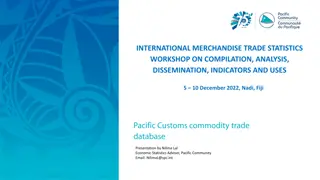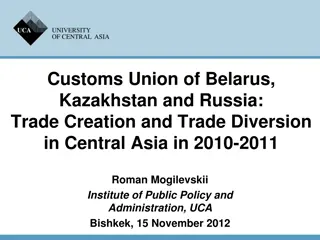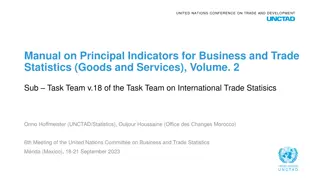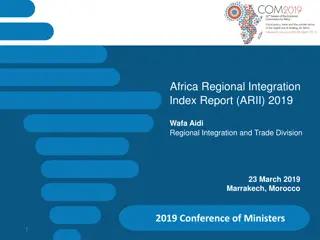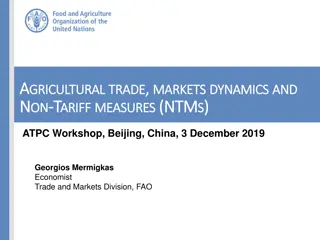Exploring European Regional Trade: Insights and Analysis
The study delves into European regional trade dynamics, focusing on sub-national units like provinces and their impact on trade patterns. Detailed trade flows data across 269 regions in 24 European countries from 2011-17 are analyzed using the gravity model. The significance of geographical level in bilateral trade, the influence of bilateral distance on trade, and the limitations of the dataset in capturing true international trade dynamics are discussed.
Download Presentation

Please find below an Image/Link to download the presentation.
The content on the website is provided AS IS for your information and personal use only. It may not be sold, licensed, or shared on other websites without obtaining consent from the author. Download presentation by click this link. If you encounter any issues during the download, it is possible that the publisher has removed the file from their server.
E N D
Presentation Transcript
Exploring European Regional Trade Marta Santamar a, Jaume Ventura & U ur Ye ilbayraktar Discussant s comments Jeffrey Frankel, Harvard University & NBER 45thAnnual NBER ISoM, Bank of Greece, Athens 21 June, 2022
Fig. 7: Normalized Market Shares: Foreign Exploring European Regional Trade Analysis of intra-European trade: between countries ( border effect ), between regions within a country (sub-national regional effect ), Within sub-national regions ( home effect ). Santamaria, Ventura & Yesilbayraktar is a SaVvY paper. Very thorough. Please explain in the first paragraph what you mean by region : = a sub-national unit, like a province. E.g., Catalonia. Otherwise, a region could be supra-national. E.g., Scandinavia. In Google Scholar, regional trading has the latter interpretation. 2
The dataset is exciting: Detailed trade flows across European regions, by industry, from European Road Freight Transport survey. Goods trade among 269 regions, 24 European countries (2011-17). A nice application of the gravity model. Valuable to have such granular data for sub-national units. One theme: trade at level of sub-national regions differs from national level. But I notice some respects in which it looks similar. Home bias is sort of fractal. Data limitations: Trade only within Europe. The European focus is fine. But, e.g., European remoteness (Fig.12, p.23) differs from true international remoteness. Only trucking data. No train, ship, or air transport. Must make a big difference, in particular, for islands. In fact, how are Mediterranean islands counted at all? 3
Size of pair of units explains some of bilateral trade, but the geographical level appears more important. Figure 5: Actual vs Predicted: log(Xnm) p.14; was Fig. 3 Within-region Within-country Actual bilateral trade International Trade predicted solely by size of units 4
Essential gravity control: bilateral distance Distance actually traveled is indeed better than straight-line distance, though a few gravity studies have measured shipping distance. SVY: Estimated effect of (log) bilateral distance on (log) trade 1. Many other gravity studies have found the same. One is tempted to declare a universal law: increasing bilateral distance by 10% reduces bilateral trade by 10%. It s a contribution to show that it works even on small regional distances. SVY: The distance coefficient seems robust. It does not correlate strongly with size of the country, number of regions, type of government, or structure at the country level. Results aren t much affected if specification allows non-linearity in distance (Table 1, p.28). I.e., the effect going from 10 miles to 11 going from 1,000 to 1,100 ? 5
After normalizing by size, distance explains much of home bias. Figure 15: Normalized Market Shares: Data vs Predicted, p.26 Within- region Actual Normalized Market Share, aka Trade Intensity or Concentration ratio. Within- country International Predicted by distance (in calibration exercise) 6
Other controls in gravity equation are also of interest. Most show the expected significant coefficient: Common-language dummy .76. Common-EU 1.8 (> FTA 1.3 > 0.5 in Head & Mayer, 2014) & Common-Schengen 1.2. But common-currency dummy insignificant through most of paper (6/10 draft), contrary to Rose (2000) and many who followed. I had wondered if it might be because the only common currency = . is known to have a much smaller trade effect than other currency unions. But CU dummy finally shows significance in an unexpected place: Table 7. Common currency here has significant effect on both trade & social interactions. Why only in Table 7 (p.59)? 7
The standard global gravity model uses some other controls that are not here. Some are less relevant for exclusively European trucking data: landlockedness, length of coastline, colonial relationships. But at least one robustly trade-promoting variable in the gravity literature might also apply to these European data: Contiguity or adjacency or common border . Berlin-Amsterdam trade > Berlin-Malmo? 8
Major conclusion. Beyond the well-known home bias at the national level, there is also a strong home bias at the regional (sub-national) level. (E.g., Table 3, 6/10 draft.) It controls for some newish & significant determinants of regional trade. Positive influences on regional home bias: geographic isolation -- Island region, mountain region, European remoteness. Negative effects on regional home bias: cosmopolitanism -- Motorway density, manufacturing share of employment, Public employment share; migrant share. tho they disappear under fixed effects. 9
s A motivating finding: apparent sub-national home bias findings are genuine and not attributable to aggregation of data into larger geographic units as in Coughlin & Novy (2021); Hillberry & Hummels (2008). SVY use the difference between political boundaries and the boundaries in their statistical data set (which separate regions more arbitrarily) to get at the geographical aggregation problem. Conclusion: These results suggest that effects of political borders exist within countries and are not caused by the statistical aggregation. 10
Governments play an important role in driving the border effects within countries. Interesting, but not surprising. Many countries have trade barriers between their provinces or states. E.g., Canada (beer). China. In 2022, a new national unified market as half of dual circulation . In theory, the US does not have barriers between states, thanks to the Interstate Commerce Clause of the Constitution. 11
s Extensive vs. intensive margin of trade A theme highlighted throughout, how different is home trade [within the region] vs. domestic and especially foreign trade (p.57). The extensive margin of trade, here represented by the # of industries a region trades with itself and the number of shipments that are made by each industry, explains almost half the variation of home trade that we see across regions (45.6%) By contrast, the intensive margin explains most of the variation in flows between regions. Might that be explained if economies of scale in the size of each shipment are more important when selling at longer distances? You wouldn t use containerized cargo to ship a few miles. 12
Early literature on bias toward intra-national trade Wei (1996): average OECD country imports 2 times as much from itself as from an otherwise identical foreign country. Nitsch (2000): average EU country trades 10 times as much intranational as internationally with an EU partner country of similar size & distance. The original case with data on intra-provincial trade was Canada. SVY have McCallum(1995) National borders matter: Canada-US regional trade patterns, AER. But another is Helliwell (1995, 1997, 2000). The original motivation for McCallum-Helliwell was the case of Quebec. Partisans of independence argued that Quebec could prosper by trading with the US. The gravity estimates showed Quebec far more dependent on intra-Canadian trade than on trade with the US. By a factor of 20, before Canadian-US FTA. Factor of 3-5 subsequently. 13
s References also relevant, but missing Engel & Rogers (1996), "How Wide is the Border? AER. Parsley & Wei (2001), JIE . Cavallo, Neiman & Rigobon (2014), QJE. Rose (2000), One Money, One Market: Estimating the Effect of Common Currencies on Trade, EP; and the many associated CU-motivated papers that followed. True, the Rose data set is mostly sovereign countries; but it also includes some sub-national units. Effect of Political union dummy on bilateral trade in Rose research: coefficient estimated at 1.3; Or 1.1 in 2002 paper; controlling for common language, currency, & many other gravity variables => French overseas departments Martinique & Guadeloupe trade 3.0 times [=exp(1.1)] as much with mainland France as do sovereign former colonies Dominica & Saint Lucia. 1.2 Effect of international border in S-V-Y, Table 1, when controlling for language. SVY have far better data to get at this. But interesting that answer looks similar. 14
Exploring European Regional Trade by Santamar a, Ventura & Ye ilbayraktar Jeffrey Frankel, Harvard University ISoM, Bank of Greece, Athens, 21 June, 2022
Appendix 1: Distance explains much of home bias, but not all. Figure 7: Normalized Market Shares: Data vs Predicted, p.17 Within- region Actual Normalized Market Share, aka Trade Intensity Within- country International 16
Appendix 2: Governments play an important role in driving the border effects within countries. Possible welfare implications for policy? In a Krugman (1980, 1991) type trade model, nearby units constitute Natural Trading Areas: => The priority for removing trade barriers should be among neighbors. Intuitively, trade-creation will dominate trade-diversion. Up to a point. But the New trade theory of monopolistic competition has been overtaken by the New new trade theory of heterogeneous firms. Head & Mayer (2014), Gravity Equations: Workhorse, Toolkit, & Cookbook. 17











